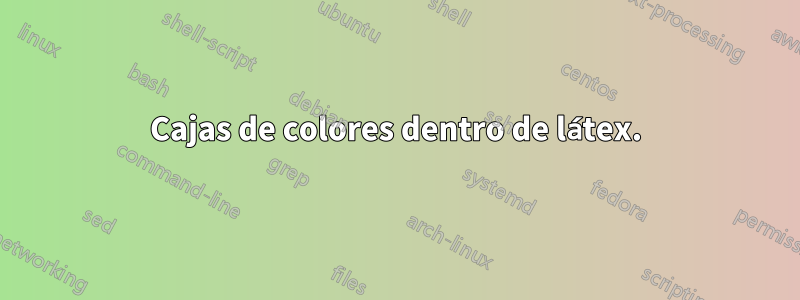
Quiero hacer cajas de colores con diferentes colores y no puedo entender la función del orden mybox{}. Te adjunto un ejemplo que  puede ayudarte.
puede ayudarte.
escribo el codigo
\documentclass[a4paper]{report}
\usepackage[greek]{babel}
\usepackage[iso-8859-7]{inputenc}
\usepackage{xcolor}
\usepackage{blindtext}
\usepackage{tikz,tkz-tab,amsmath}
\begin{document}
\newcommand{\mybox}[1]{%
\begin{center}%
\begin{tikzpicture}%
\node[rectangle, draw=green, top color=green!10, bottom color=green!90, rounded corners=5pt, inner xsep=5pt, inner ysep=6pt, outer ysep=10pt]{
\begin{minipage}{1.05\linewidth}#1\end{minipage}};%
\end{tikzpicture}%
\end{center}%
}
\mybox{\textlatin{\blindtext}}
\end{document}
y el resultado es este:

Respuesta1
Puede agregar un parámetro \myboxen el que pueda especificar un color alternativo. Entonces
\mybox{text}
producirá un cuadro que utiliza green(el color predeterminado como se especifica en la myboxdefinición), pero
\mybox[red]{text}
utilizará red:

Sin embargo, le recomendaría que utiliceelmdframed paqueteen cambio:

Código: tikznodo
\documentclass[a4paper]{report}
\usepackage[greek]{babel}
\usepackage{xcolor}
\usepackage{blindtext}
\usepackage{tikz}
\newcommand{\mybox}[2][green]{%
\begin{center}%
\begin{tikzpicture}%
\node[rectangle, draw=green, top color=#1!10, bottom color=#1!90, rounded corners=5pt, inner xsep=5pt, inner ysep=6pt, outer ysep=10pt]{%
\begin{minipage}{1.05\linewidth}#2\end{minipage}};%
\end{tikzpicture}%
\end{center}%
}
\begin{document}
\mybox{\textlatin{\blindtext}}
\mybox[red]{\textlatin{\blindtext}}
\mybox[blue]{\textlatin{\blindtext}}
\end{document}
Código:mdframed
\documentclass{report}
\usepackage[greek]{babel}
\usepackage{xcolor}
\usepackage{blindtext}
\usepackage[framemethod=tikz]{mdframed}
\newcommand{\mybox}[2][]{%
\begin{mdframed}[backgroundcolor=green!70,roundcorner=10.0pt, #1]
#2%
\end{mdframed}
}%
\begin{document}
\mybox{\textlatin{\blindtext}}
\mybox[backgroundcolor=red!40]{\textlatin{\blindtext}}
\mybox[backgroundcolor=blue!25]{\textlatin{\blindtext}}
\end{document}
Respuesta2
Porque ya usas el paquete tikzcaja de coloreses otra alternativa. La página 12 del Manual describe "mybox" como:
\newtcolorbox[⟨init options⟩]{⟨name⟩}[⟨number⟩][⟨default⟩]{⟨options⟩}Crea un nuevo entorno⟨name⟩basado entcolorbox. Básicamente,\newtcolorboxfunciona como\newenvironment. Esto significa que el nuevo entorno⟨name⟩opcionalmente toma⟨number⟩argumentos, donde⟨default⟩está el valor predeterminado para el primer argumento opcional. Se⟨options⟩entregan al tcolorbox subyacente.
Los teoremas se establecen con \tcbuselibrary{theorems}(ver página 185 y siguientes).
\documentclass[a4paper]{report}
\usepackage[greek]{babel}
\usepackage[iso-8859-7]{inputenc}
\usepackage{xcolor}
\usepackage{blindtext}
\usepackage{tikz,tkz-tab,amsmath}
\usepackage{tcolorbox}
\newtcolorbox{mybox}{colback=red!5!white,colframe=red!75!black}
\newtcolorbox{mybox_1}{colback=blue!5!white,colframe=blue!75!black}
\newtcolorbox{mybox_2}{colback=green!5!white,colframe=green!75!black}
\tcbuselibrary{theorems}
\newtcbtheorem[number within=section]{mytheo}{My Theorem}%
{colback=green!5,colframe=green!35!black,fonttitle=\bfseries}{th}
\begin{document}
\chapter{Watt}
\section{James}
\begin{mybox}
\textlatin{This is my own box.}
\end{mybox}
\begin{mybox_1}
This is my own box.
\end{mybox_1}
\begin{mybox_2}
\begin{equation}
V= \pi \cdot r^{2} \cdot h
\end{equation}
\end{mybox_2}
\begin{mytheo}{This is my title}{theoexample}
\textlatin{This is the text of the theorem. The counter is automatically assigned and, in this example, prefixed with the section number. This theorem is numbered with \ref{th:theoexample} and is given on page\pageref{th:theoexample}.}
\end{mytheo}
\end{document}



